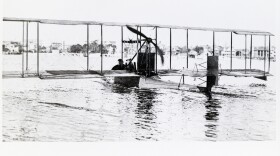-
HART is charging once again after the route from USF to downtown Tampa was free last year under a pilot program.
-
Jan. 1 marks the 112th anniversary of the first commercial airline flight. It happened on a short jaunt from St. Petersburg to Tampa.
-
A newly formed group called Pride of Tampa is planning to host a festival in March after Tampa Pride canceled its annual parade due to the "current political and economic climate."
-
Jewish officials in Tampa Bay say the shootings will inevitably lead to more security measures at Jewish institutions around the world.
-
J. Leonard and George Levy Avenue, in the shadow of Raymond James Stadium, honors the brothers who helped brand "Tampa Bay" and lay the groundwork for Super Bowls and other big-time sports.
-
For "The Bay Blend" podcast, WUSF's Sky Lebron joined the Tampa Bay Ship Model Society to learn about their niche hobby and why it takes a whole lot of determination.
-
"Operation Home for the Holidays" located more than 100 missing or endangered children in Central Florida and beyond, ranging from 23 months to 17 years of age. It also resulted in six felony arrests.
-
"Live and Local" digs into local change, pride and spirited competition. Included are discussions on the stalled USF presidential approval and neighborhoods preserving their heritage.
-
Counties like Pinellas and Hillsborough get as much as one-third of their revenue from property taxes. If these are eliminated, a study shows services could be cut, or other taxes would have to go up.
-
Hurricane Melissa hit Jamaica Tuesday as a powerful Category 5 storm — the worst the island has ever seen. Tampa Bay residents with ties to Jamaica are concerned.
-
Fish, barnacles, oysters, water and sediment are being studied by researchers with the USF College of Marine Science.
-
 A new historical marker honors Tampa's Black music historyThe sounds of jazz, blues, and soul may no longer echo down Central Avenue, but the historical impact that once defined the street will live on.
A new historical marker honors Tampa's Black music historyThe sounds of jazz, blues, and soul may no longer echo down Central Avenue, but the historical impact that once defined the street will live on.
Play Live Radio
Next Up:
0:00
0:00
Available On Air Stations











